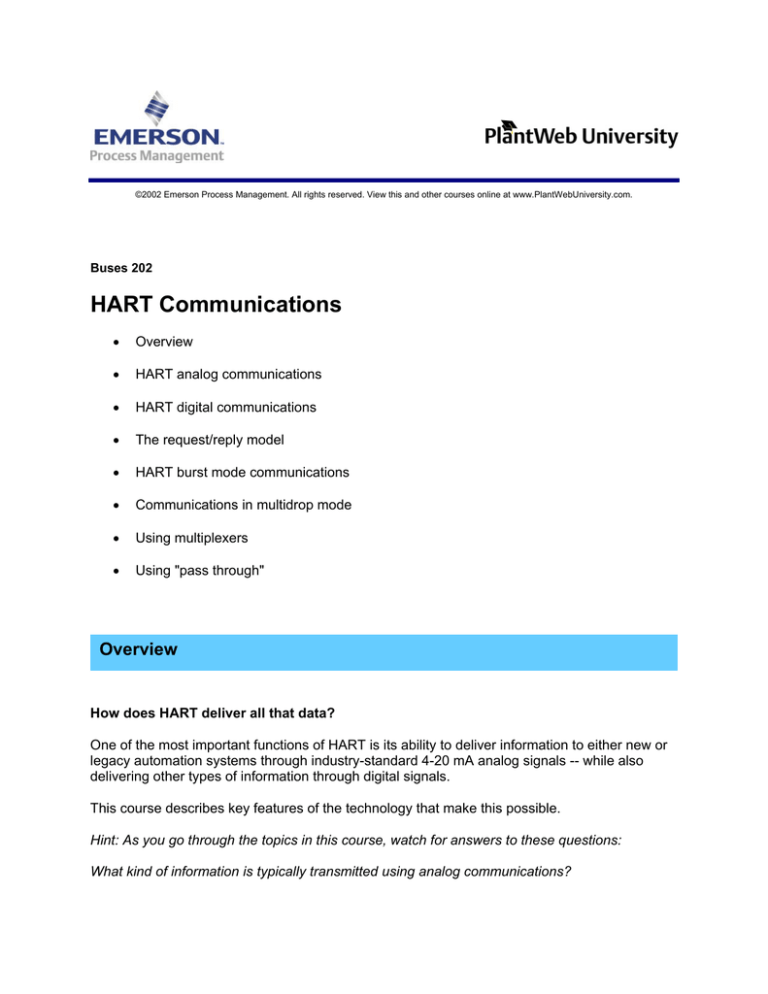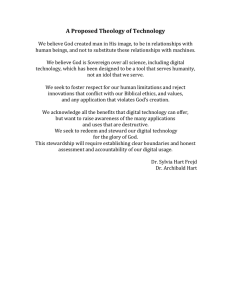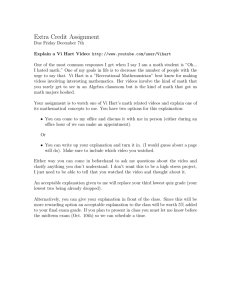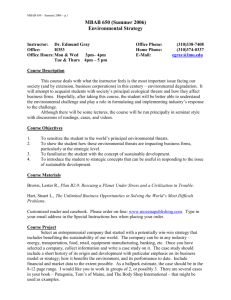
©2002 Emerson Process Management. All rights reserved. View this and other courses online at www.PlantWebUniversity.com.
Buses 202
HART Communications
•
Overview
•
HART analog communications
•
HART digital communications
•
The request/reply model
•
HART burst mode communications
•
Communications in multidrop mode
•
Using multiplexers
•
Using "pass through"
Overview
How does HART deliver all that data?
One of the most important functions of HART is its ability to deliver information to either new or
legacy automation systems through industry-standard 4-20 mA analog signals -- while also
delivering other types of information through digital signals.
This course describes key features of the technology that make this possible.
Hint: As you go through the topics in this course, watch for answers to these questions:
What kind of information is typically transmitted using analog communications?
What kind of information is typically communicated using digital communications?
When would you use multiplexers, and when would you use pass-through?
HART analog communications
HART analog communications use industry-standard 4-20 mA signals. That means HART
devices can perform their basic functions with any host system that has 4-20 mA I/O capability.
The limitation is that only one parameter can be communicated on a 4-20 mA input or output.
Typically that information is a process variable from a transmitter, or an output to a final control
element.
HART digital communications
HART's digital communications carry additional kinds of information that aren't communicated
by the analog signal.
The key attribute of HART digital communications is that the digital signal — which uses the Bell
202 standard frequency shift keying, or FSK — is superimposed on the analog signal.
This attribute allows the analog signal to be used by a host for process control, and the digital
signal to be used by the same or a different host to communicate information related to device
configuration, non-real-time diagnostics, and status monitoring.
Asset management applications using this information can dramatically increase configuration
and maintenance productivity, and provide diagnostic and status information that improves plant
reliability and performance.
The request/reply model
HART digital communications uses a request / reply communications model. This means that, in
general, HART devices won't transmit any information unless a request is sent from the host to
the device.
For example, if a HART device detects a failure condition in itself or the process, the HART
device cannot communicate this information to the host unless the host specifically requests
that information from the device.
The exception to this model is something called burst mode communications.
HART burst mode communications
HART devices can send a single piece of information continuously from a device without
repeated host requests.
This method — called "burst mode" — is usually used to send a single variable such as a
process variable digitally.
Using burst mode, more then 3 messages per second can be transmitted.
Communications in multidrop mode
The HART protocol supports multiple devices on a single wire pair. When this multidrop mode is
used, analog communication is not available.
A typical message rate using request / reply digital communications is less than 2 messages a
second for all devices on the wire. This limits practical use of multidrop digital communication to
slow data-acquisition applications.
Using multiplexers
Many installed hosts aren't designed to accept HART information in digital form. One solution to
this problem is to have external multiplexers read the digital signal and extract the digital
information from the devices.
In this approach, the HART device is attached both to the control host and to the multiplexer. To
minimize wiring and cost, the multiplexer can be cable-connected to the host's termination
panel. Although this solution increases the cost of the HART installation, reductions in
maintenance cost generally pay back the investment in a very short time.
Using “pass through”
Some hosts are able to capture and pass HART digital information to other applications — such
as asset management software — using a mechanism commonly called "pass through." The
HART digital bitstream is captured by the host input or output card and passed unread through
the host architecture to platforms and applications that use the digital information.
Hosts that support pass-through functionality reduce the cost of acquiring and using the HART
information by eliminating the need to install separate multiplexer systems.



